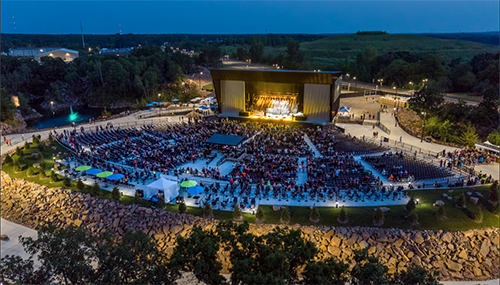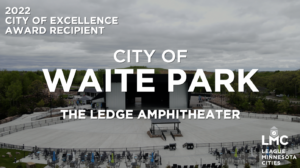Waite Park Transforms a Quarry Into a Gorgeous Amphitheater
By Deborah Lynn Blumberg

In 2015, granite quarry mining company Martin Marietta gifted a 20-acre abandoned quarry site it owned in Waite Park to the city. The site was mined years ago for its granite, then stood vacant. The land was unique for its large granite stockpiles amid the heavily wooded area and two granite, water-filled quarry pits in the woods.
Waite Park City Administrator Shaunna Johnson recalls walking through the old, abandoned site years ago with Waite Park Public Works Director Bill Schluenz. “I’ve always referred to the site as the hidden gem,” she says. “I remember saying, Wow, what could we do with this? It’s such a cool piece of property. And it evolved from there.”
After initial brainstorming sessions in 2015, City Council members considered the idea of building a baseball facility next to the quarry. Preliminary drawings were done, Johnson says, but the idea lost traction. At around the same time, the city worked with St. Cloud State University on a land use study that included surveying the public on what kinds of amenities it wanted. Recreational opportunities scored high.
Over a period of several years, Waite Park transformed the abandoned quarry into what’s now a premiere music and performance destination that’s attracted top performers like Bonnie Raitt, Willie Nelson, and Sheryl Crow, and has sold about 50,000 tickets its first full season. Waite Park’s initiative was the winner of a League of Minnesota Cities 2022 City of Excellence Award.
“I’ve always referred to the site as the hidden gem. I remember saying, Wow, what could we do with this? It’s such a cool piece of property. And it evolved from there.” SHAUNNA JOHNSON WAITE PARK CITY ADMINISTRATOR
“We took an area that was filled with poison ivy and graffiti and made it into a showpiece for the state and for the region,” says Waite Park Mayor Rick Miller. “We really didn’t know what we were going to do with this property beyond just a park, and what we have constructed is beyond our expectations.”
Extensive information gathering
The idea to build an amphitheater came from a discussion city staff and the Council had with the city engineer. His firm had worked on an amphitheater project in Indiana. City Council members’ interest was piqued. “There was really nothing like that around here,” Johnson says.
The prospect of bringing more tourists from across the region to Waite Park was enticing for the added revenue it could offer. As Waite Park officials gathered information for a potential amphitheater, they also completed a new roadway that connected roads in the area and paved the way for the site development.
In 2016, Johnson, Schluenz, and Miller, along with other city officials, started touring amphitheaters across the Midwest to gather information and ideas. The goal was to see what worked well at the amphitheaters and learn lessons from their founders.
When traveling, city officials took every opportunity to tour amphitheaters. Officials toured the Blue Stem Amphitheater in Moorhead, Minn., the Providence Amphitheater in Bonner Springs, Kan., the McGrath Amphitheater in Cedar Rapids, Iowa, the Chesterfield Amphitheater outside St. Louis, Mo., the Walmart Arkansas Music Pavilion in Rogers, Ark., and the Pinewood Bowl in Lincoln, Neb., among others. In total, city officials saw a dozen venues to gather information for their project.
After visits and discussions with the managers of the Arkansas and Kansas amphitheaters, Waite Park decided to think bigger than the 2,000 to 3,000 capacity venue originally envisioned, Johnson says. “Then, we’d be able to have a better variety of acts.”
The city wanted a venue large enough to earn sufficient revenue to make the project profitable. But a venue that was too big could bring unwanted traffic or drive the city into debt if it proved unsuccessful. Now, the venue can hold around 6,000 people standing and portable seats accommodate about 4,200.
“There’s always this balancing act,” Johnson adds.
Community input and preserving the land
Johnson met staff from venue manager New West Presentations when touring the Providence Amphitheater. The connection evolved over time. New West had experience managing amphitheaters. They came to Minnesota to meet city officials and tour the quarry site, and continued to be involved in the project. Now, they manage the venue.
“We leaned on them for a lot of good advice,” Johnson says.
From the tours, officials also learned that, while some amphitheaters were beautiful, they weren’t completely functional. Johnson and her colleagues wanted to make sure their amphitheater would be both. So, from early on they involved both architects and the eventual site manager in drawing up and finalizing plans.
“If you don’t involve the people who are actually operating it from the start, it’s hard to have it work out really well,” Johnson says. The city worked with New West and designers for about five years on plans before starting construction.
“Lots of people have driven over 60 miles to come here, and they say they’ll be coming back. We’re getting huge accolades across the board.” BILL SCHLUENZ WAITE PARK PUBLIC WORKS DIRECTOR
Top goals were to preserve the history and natural beauty of the old mine — creating a true oasis — and to involve the community. Massive rocks were relocated around the site to create a natural-looking landscaping, and as many trees as possible were preserved in the wooded areas.
Architects also recommended steel prefabricated buildings as part of the initial design. That, however, eliminated most local contractors from bidding on the project. Instead, officials modified the plans to wood frames. “That allowed us access to our local contractors,” Johnson says. The metal tin now on the buildings is a nod to the area’s history, but adds a modern flair.
Waite Park held several public meetings on the project and solicited names for the new venue from the public. Council members whittled down submissions to the top four, and then selected a winner.
A new anchor for Waite Park
Waite Park funded what was ultimately the $17 million amphitheater project through local option sales taxes, local donations, as well as state bonding assistance.
Before Waite Park received its money from the state, in January 2018, the Minnesota Senate Bonding Committee came to tour the site on a frigid winter day. Waite Park rolled out the red carpet — literally. They cleared out rocks and created ramps throughout the site that they covered with red carpeting to make it easier for senators to navigate. The House Bonding Committee also visited the site in summer 2017, and city officials gave them a parting gift of granite paperweights made from the quarries.
Design posters dotted the area showed politicians what it could be transformed into. “I think that made a big difference in our ability to be able to get funding approved,” Johnson says. “They could visualize exactly what we were talking about.” In May 2018, the city got $5 million in state funds that it matched dollar for dollar.
“We’re thankful for the state and their commitment to this project,” says Johnson. “It certainly would not have been built without their assistance.”
For Schluenz, project challenges that stood out included managing the unpredictable bedrock in the area. While the city surveyed the area before digging and conducted test borings in areas in which it planned to put structures, exactly what sat below the surface and where wasn’t totally clear until they broke ground.
“You just start digging to put in pipe and then you hit bedrock and have to deal with it,” Schluenz says. “We had to blast more rock than we thought we would and rearrange some of the piping. Bedrock is very fickle. You never know.”
“This is significant to Waite Park and to the entire region. This venue will put Waite Park on the map.” RICK MILLER WAITE PARK MAYOR
City departments worked together to innovate and to make the project a success. For example, Public Works transformed a heavily wooded area on the south side of the site with large spoil piles into a beautiful park and trail system.
Before the Ledge, Waite Park was already a regional destination center with its conference center, hotels, restaurants, bars, box stores, and trailheads. The amphitheater amplifies that and reflects the city’s updated tagline and logo — where Minnesota connects.
“The amphitheater is now seen as an anchor,” says Johnson. “Hotels are packed and restaurants are packed. That’s what we want. That’s why we built it.”
National events are planned for May through September, with local ones still happening in October and April. If the venue reaches 60,000 to 80,000 visitors this season — a real possibility — that will mean some $8 to $10 million in economic impact.
“This is significant to Waite Park and to the entire region,” Miller says. “This venue will put Waite Park on the map.”
City leaders hope to soon raise enough money to start on phase two of the project, which includes winterizing certain structures and building another restroom. To other cities considering a similar project, Schluenz says “do your homework.” Take the time to visit other facilities. “Planning is key,” he says.
“Lots of people have driven over 60 miles to come here, and they say they’ll be coming back,” says Schluenz. “We’re getting huge accolades across the board. The amphitheater means a great deal to the city and to the region.”
Deborah Lynn Blumberg is a freelance writer.


